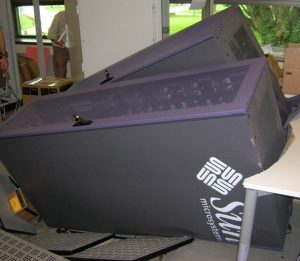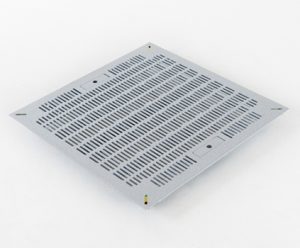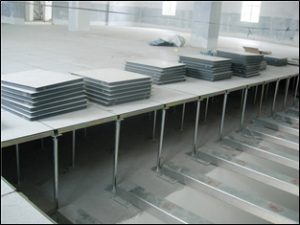The Benefits Of High Load Rated Panels
Install 4,000lb and 5,000lb Panels And Be Prepared For Future Growth
With more than 35 years in the data center business, and drawing our employees’ 20+ years of flooring experience, we’ve just about seen it all. One of the most important lessons we’ve learned over the years – people always want their spaces to do more. More computing, more multipurposing, more density.
But unfortunately that same perspective doesn’t apply when people initially build out their data centers.
Measure Twice, Spend Once
According to a study by the US Chamber of Commerce the average data center costs $215.5 million to build, and encompasses just over 165,000 net rentable square feet.
That comes out to just over $1,300 per square foot.
But the average cost of raised flooring in these data centers is just over $16 per square foot – or just over 1% of that total facility cost.
The floor represents such a small portion of the total cost, it can be overlooked or its importance minimized during data center construction. But a quality floor is the foundation of success in that space.
Here’s the problem we see time and time again:
People install the cheapest floor they can source into their data centers, and then have to replace that floor when the loads they need to put on them exceeds the load limits of the flooring.
A 1,250 panel isn’t going to last long in a high density data center. And even if your data center doesn’t start out as high density, it will evolve into one much sooner than you think.
That’s why we encourage you to install a floor that can handle 4,000 and 5,000 pound loads when you initially build your floor. Use heavy duty stanchions and high load rated panels when you build the data center, so it’s prepared for future growth.
What Can Happen If You Don’t?
A key customer experienced a data center floor collapse. They increased the server and rack density in the data center without understanding the original flooring’s weight rating.

When we walked this customer’s facility we quickly noticed some of the key hallmarks that indicate a floor is not holding up under daily use:
Delamination, deformation, bowing, and dented panels all indicate floor issues.
The floor panels were also uneven. Panels that are placed into the floor grid system must be flat at all times. This maintains structural integrity and prevents tripping hazards. When you choose panels that have integrated adjustable leveling features on each corner, they can be properly installed into the grid system and they’ll be flat and securely in place for proper weight distribution.
One Stop Shopping From A Single Source Provider
We’re such emphatic supporters of this overbuilding concept, we’ve curated a collection of high load rated flooring products that support the current and emerging needs of your facility:
 Our solid steel panels are available in 4,000 lb and 5,000 lb load ratings, in both Imperial and Metric sizes. They include built in corner levelers to ensure each floor is safe, secure, and stable, whether they’re put in an existing framework or a new build. Choose a Gray Flek or Crystal White powder coat for these panels.
Our solid steel panels are available in 4,000 lb and 5,000 lb load ratings, in both Imperial and Metric sizes. They include built in corner levelers to ensure each floor is safe, secure, and stable, whether they’re put in an existing framework or a new build. Choose a Gray Flek or Crystal White powder coat for these panels.
 Airflow is important in every data center, and we believe you should not have to choose between load limits and directional airflow. Our slotted airflow panels are available in load ratings up to 4,000 lb and our chamfer panels are available in load ratings up to 5,000 lb. Both are available in Imperial and Metric sizes, include built in corner levelers, and cowith a Gray Flek or Crystal White powder coat.
Airflow is important in every data center, and we believe you should not have to choose between load limits and directional airflow. Our slotted airflow panels are available in load ratings up to 4,000 lb and our chamfer panels are available in load ratings up to 5,000 lb. Both are available in Imperial and Metric sizes, include built in corner levelers, and cowith a Gray Flek or Crystal White powder coat.
Heavy Duty Framework and Quality Installation
 There are so many parts necessary for a quality floor installation, and we stock the supplies – pedestals, heavy duty stringers, etc. – that ensure your floor is stable and durable for years to come. Our flooring experts can work with you to ensure your floor fits your needs, is installed correctly, and is maintained for a safe, secure working and computing environment.
There are so many parts necessary for a quality floor installation, and we stock the supplies – pedestals, heavy duty stringers, etc. – that ensure your floor is stable and durable for years to come. Our flooring experts can work with you to ensure your floor fits your needs, is installed correctly, and is maintained for a safe, secure working and computing environment.
The Key Takeaways
It’s so important for users to understand that:
- Data center raised floors have precise requirements for use, maintenance and load ratings – these specifications are critical for long life spans and appropriate performances. Occupants need to understand and follow these requirements.
- If you’re in a space and can’t tell what the ratings of your floor are, call in some expert help. We spend a lot of time walking through facilities and educating users on the type of flooring they have and the use parameters for those floors.
- A best practice is to use higher load rated solid steel or concrete-filled panels to support heavy equipment weights. Appropriate weight specifications are key to preventing early wear and potential damage to raised floor panels and entire floor grid system.
We see it time and time again. Users don’t accurately anticipate how they’ll use their floor and underestimate how much cabinets and equipment weigh, they choose the cheapest flooring option, and then end up paying for a floor twice. When you choose a higher load rating initially, you save time, money, and disruption. Measure twice, spend once!
Leave a Reply
